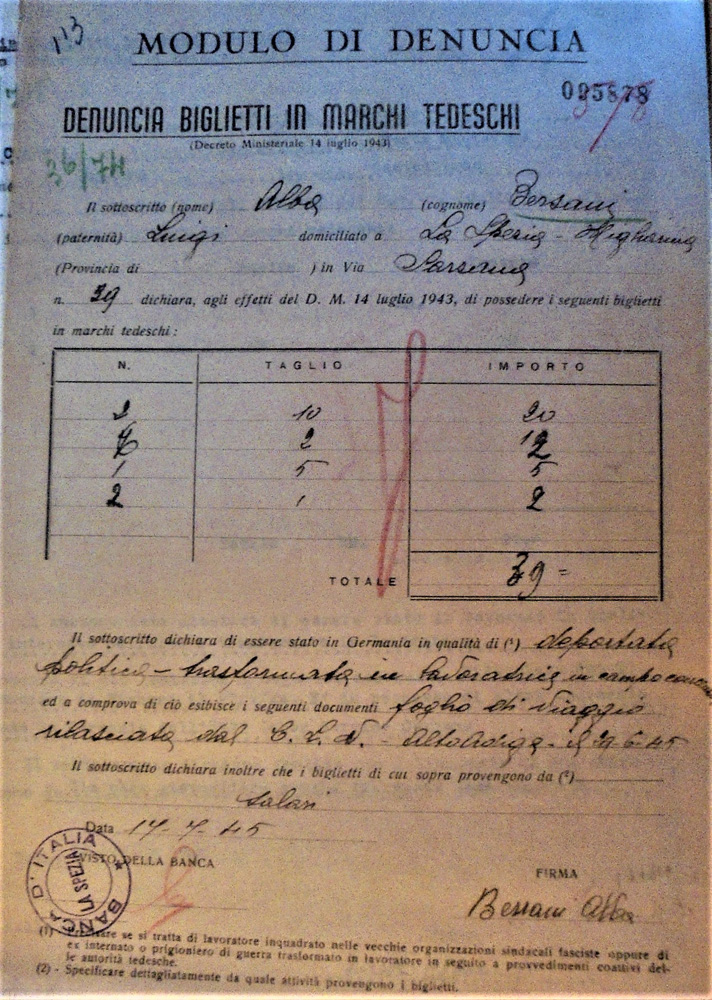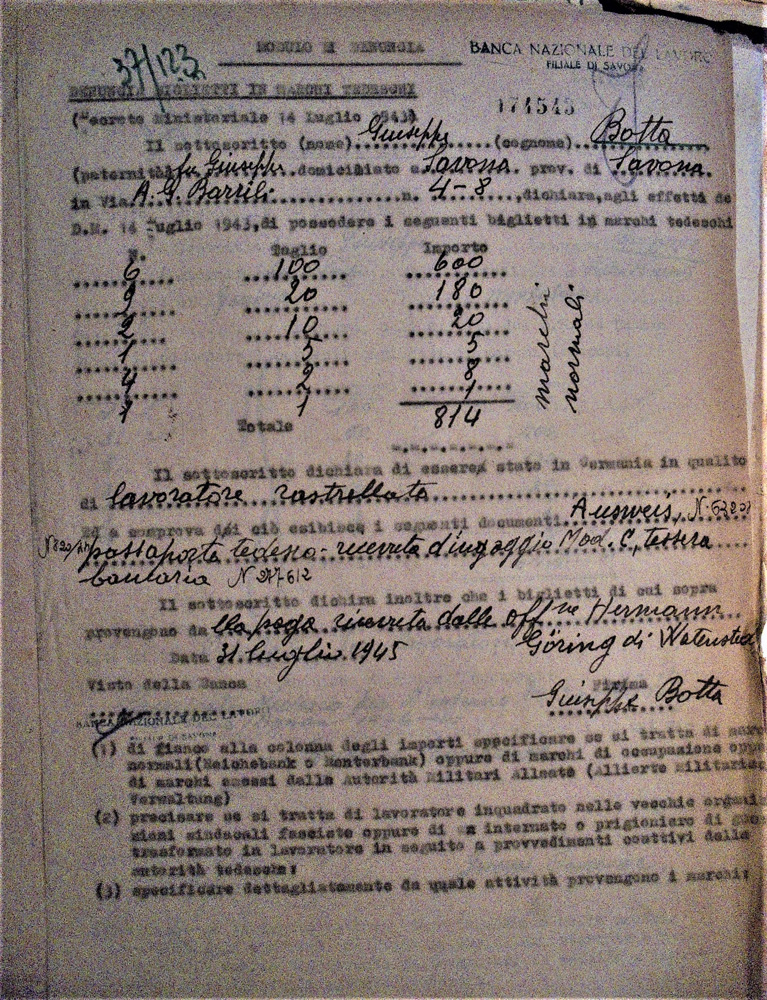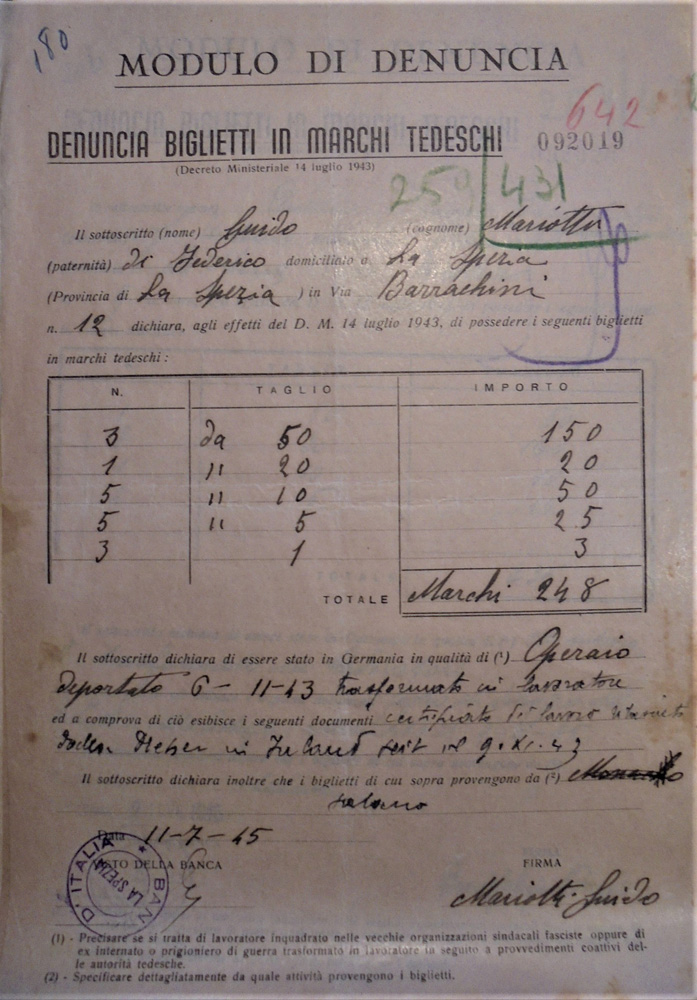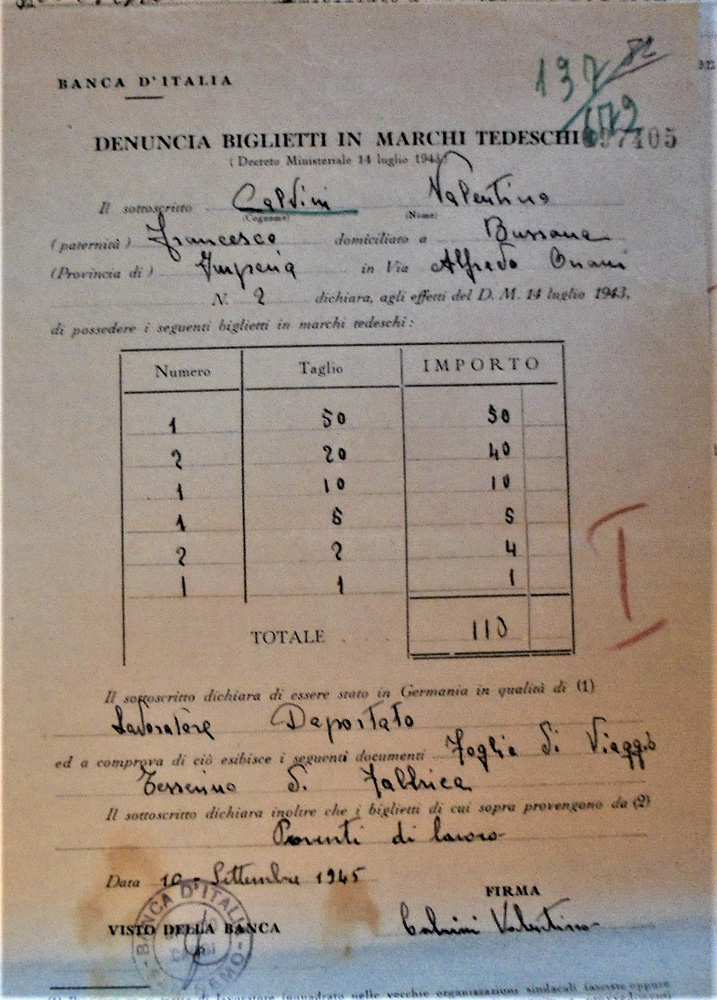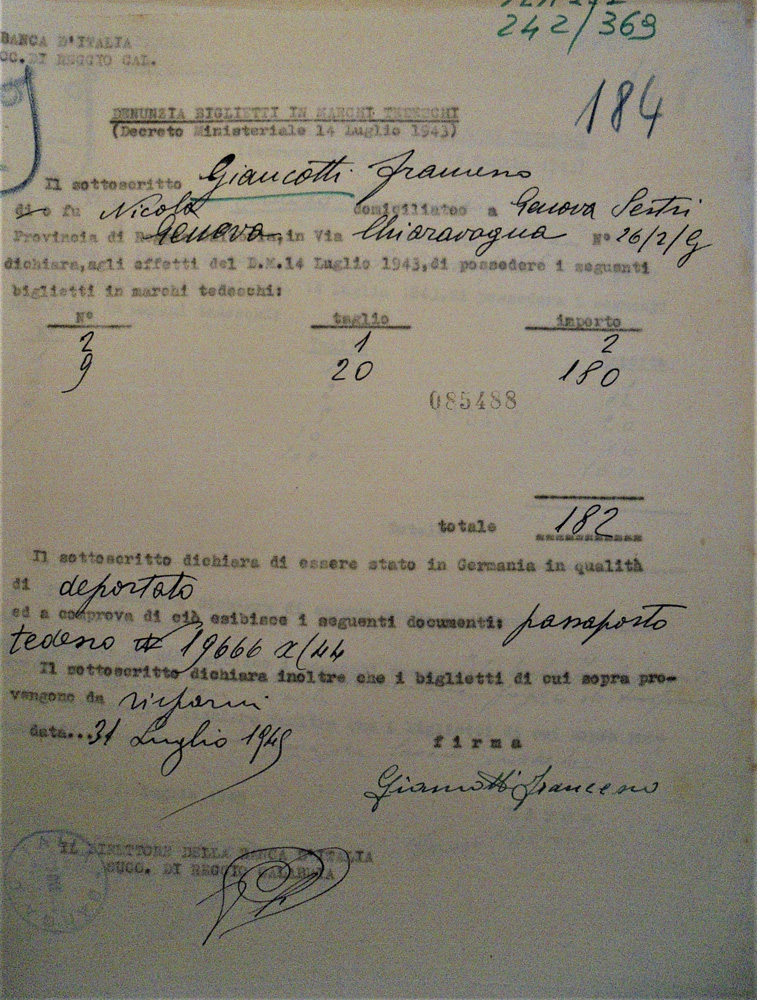In Liguria, a region characterised by an industrial economy and an unproductive countryside, ALL the practices introduced by the occupying forces and by the Italian Social Republic to drain manpower for the Reich were adopted with varying intensity over time and from place to place:
- encouragement of voluntary enlistment
- direct transfer of manpower by companies
- conscription
- call-up of some age groups of those eligible for military service
Given the poor results achieved in relation to their objectives, the Nazi-Fascists resorted to the most brutal forms of coercion:
- raids during roundups targeting partisans, in factories and among strikers
- urban dragnets targeting political opponents, the unemployed, the marginalised, petty criminals, and dodgers of military and labour service
- emptying prisons of inmates.
Thus, between 8,600 and 9,300 residents out of a population of about 1,500,000 were taken to work in the Reich.
Genoa and its province
In Genoa and its province, the response to the recruitment campaigns left much to be desired, also in consideration of the employment situation:
- in the capital and in some coastal towns, much of the industrial apparatus remained operational (iron and steel and mechanical sectors, shipbuilding, weapons, manufacturing), given that the occupying forces deemed it advantageous to continue production locally to support their war economy
- thousands of men and women found employment in companies working for the Todt (15,000 as of 3 June 1944) or directly for the Germans (several thousand)
- in the countryside, labour was scarce.
This explains the frequent recourse to coercive measures, including the operation carried out by the Nazi-Fascists on 16 June 1944 targeting workers who had gone on strike, which involved sending 1,448 industrial workers in one fell swoop to Austria and Germany.
Overall, the contribution of workers to the Reich from the territory can be estimated at 6,000-6,500 men and women.
INCE-UIC files with brief biographical note
- Francesco GIANCOTTI, born on 29/4/1913 in Genoa. Defined himself as a “Deportee”.
He was one of the 1,448 workers rounded up in Genoa on 16 June 1944 from four factories (San Giorgio, SIAC, Piaggio Carrozze Ferroviarie and Cantiere Navale Ansaldo), in the course of an operation aimed on the one hand at procuring industrial manpower for the Reich and on the other at retaliating for the strikes of the previous days. The workers were taken to Mauthausen and, after quarantine, sorted and sent to workplaces in Austria and Germany. A group of about 200 of those rounded up were employed at the MIAG in Dresden, among them Giancotti
- Mario ROLLERI, born on 14/4/1923 in Lavagna (province of Genoa). Defined himself as a “Political internee”.
On 27 September 1944 he entered the Genoese prison of Marassi, in whose registration book he was classified as “captured in a roundup”. On 27 September 1944 he was sent to San Vittore prison, from where he was deported to the Reich on 9 October 1944 as part of Operazione Carceri (the ‘prison operation’).
- Nello SISTI, born in 1911 in Massa. Defined himself as a “Political detainee”.
In the central political records he appears as an “anarchist and detainee”, a marble quarryman by trade. In June, his wife Amalia Giromini asked the head of the province for a subsidy, as she had not yet received remittances from her husband or family allowances, and was living in poverty with two children. On 7 August, the INFPS office in Genoa granted her an advance of 2,000 Lire and specified the company Edeka in Grimma in the district of Leipzig in Saxony as his place of work.
Savona and its province
Savona and Its province was a highly industrialised area (iron and steel, mechanics, chemistry, petrochemistry), with factories spread throughout the territory. The port and the tourist sector had also been important, but both had already been in decline since 1940.
Industrial activity entered into crisis at the end of 1943 due to a lack of raw materials and energy, and so the Germans on the one hand initiated projects aimed at rounding up workers, and on the other moved many factories to north of the Apennines.
On 1 March 1944, the general strike in the Savona area met with great success. In retaliation and to procure manpower, 67 workers were sent to KL (only 8 survived), and between 110 and 120 to forced labour, mostly in the large HGW iron and steel plant in Salzgitter.
Despite the low rate of applications for job offers to work in the Reich, the raids, city roundups, arrests of anti-fascists and dodgers of Labour Service, and the “emptying of prisons” meant that over 900 people were sent to work beyond the Brenner.
INCE-UIC files with brief biographical note
- Giuseppe BOTTA, born on 8/7/1898 in Savona. Defined himself as a “Worker captured in a roundup”.
Mechanical milling worker at ILVA in Savona, he took part in the strike of 1 March 1944, which was repressed with a roundup of workers in the main factories of Savona and its province. Over 200 workers were taken to the Reich employment centre in Genoa. From here, 67 were sent to the Mauthausen concentration camp and its subcamps, and between 110 and 120 to forced labour. Botta was employed, with the majority of his companions, at the Konzern Hermann Göring Werke steelworks in Salzgitter in Lower Saxony.
- Alfredo CAPARVI, born on 10/7/1908 in Savona. Defined himself as a “Civilian deportee”.
Took part in the strike of 1 March 1944 which was repressed with a roundup of workers in the main factories of Savona and its province. Over 200 workers were taken to the Reich employment centre in Genoa. From here, 67 were sent to the Mauthausen concentration camp and its subcamps, and between 110 and 120 to forced labour. Caparvi was employed, with the majority of his companions, at the Konzern Hermann Göring Werke steelworks in Salzgitter in Lower Saxony.
La Spezia and its province
La Spezia had a military arsenal with 8,000 civilian employees and was one of the main centres of the Italian war industry linked to the navy. On 8 September the Arsenale was closed and reopened only partially in the following months, and the main factories also entered into crisis due to lack of orders. The Germans removed their workforce and apparatus, as well as engaging In what was nothing short of a looting of raw materials, manufactured goods and machinery, immediately following the Armistice.
The Germans and RSI used the pool of former Arsenale employees to secure volunteers, and above all to recruit workers, sending no fewer than 400 “arsenalotti” to the Reich. There was no shortage of urban roundups, captures of the marginalised, the unemployed, “idlers and vagabonds”, and anti-fascists, as well as roundups in the towns of the province until December 1944, and some abductions from factories.
Between 1,000 and 1,100 workers were sent to Germany. The percentage of volunteers was higher than in the rest of Liguria due to the desperate conditions of the starving city, devastated by bombing and destruction by the Germans, which began to worsen further in September 1944 due to its proximity to the front.
INCE-UIC files with brief biographical note
- Alba BERSANI, born on 5/1/1923 in Vezzano Ligure (SP), seamstress. Defined herself as a “political deportee assigned as a concentration camp worker”.
Arrested in La Spezia on 28 November 1943 with her brother Athos, born on 17/9/1924 in Chiavari (province of Genoa), carpenter. Both arrived in the Genoese prison of Marassi on 12 February 1944 by order of the military command of La Spezia, where they were to remain at the disposal of the German military command (notes on the prison register). The siblings left Marassi for Germany on 11 August 1944 as part of Operazione Carceri. We have traces of Alba in the Arolsen archive where she is registered as working in Laufen in Upper Bavaria from 19 August 1944 to 13 June 1945 (we do not have the UIC file of Athos and there is no mention of him in the Arolsen Archives).
- Guido MARIOTTI, born on 30/7/1906 in La Spezia. Defined himself as a “Factory worker deported on 6-11-43 reassigned as a labourer”.
He was one of about 400 employees of the military arsenal of La Spezia dismissed after 8 September 1943 and sent to work in the Reich. In the Arolsen Archives he was registered from 13 November 1943 to 14 April 1945 as a worker at the company Johann Hunter & Co. K.G., based in Munich.
- Pietrina VITA, born on 12/18/1919 in Massa, peasant. Defined herself as a “Civilian deportee”.
She arrived in Germany on 28 March 1944, where she worked in Wesseling (district of Cologne) at the Union Rheinische Braun-Kohlen Kraftstuffe – DEA Mineralöl.
Imperia and its province
Imperia was the only province in Liguria with limited industrialisation, but it did have a relatively thriving economy thanks to profitable crops (olives and flowers) and foreign tourism; this economy was severely affected by Italy’s entry into the war. In the early months of 1944, the response to advertisements for jobs in Germany was very disappointing, and so the Germans and RSI authorities –- especially the GNR – began to carry out roundups and urban dragnets, to arrest dodgers, and to implement day and night “patrols”. These intensified in late August, when the province, in which the partisan movement was strong and combative, found itself close to the advancing front line.
On 16 October 1944, between 130 and 160 people were captured during a roundup in the Pigna district of Sanremo and sent to work in Bolzano and the network of its sub-camps, and between 15 and 17 November another 60 were taken during an anti-partisan operation in the Sanremo hill district of San Romolo. Other manpower was taken during raids in mountain and coastal towns.
In total, the inhabitants of Imperia and its province sent to work in the Reich amounted to between 650 and 750.
INCE-UIC files with brief biographical note
- Valentino CALVINI, born on 15/7/1925 in Bussana (province of Imola). Defined himself as a “Deported worker”.
Together with three colleagues from Bussana, also born in 1925, he was enlisted as a militarised worker on 14 August 1943. Posted to the 4th Army, they reached Hières on 20 August and from there were sent to build anti-landing defences near Marseilles. On 8 September they were captured by the Germans, taken to Marseilles and employed with 500 other Italians to work at the port. On 24 November, the four managed to escape and reach Menton, where they contacted a passeur to return to Italy, but a spy reported them. Once arrested, they were held for 15 days in Menton prison and from there, via Nice, were sent to the Esslingen am Neckar camp in the Stuttgart region in Baden-Württemberg. They were subsequently sent to different workplaces. Calvini was employed from 28 December 1943 to 20 April 1945 in the company Mauser Werke A.G. in Obendorf am Neckar.
- Giacomo LAURA, born on 11/26/1883 in Ospedaletti (province of Imola). Defined himself as a “Political internee (prisoner of the SS) reassigned as a worker, following coercive measures by the German authorities”.
The whole Laura family was involved in the Resistance. From 13 July 1944 Giacomo worked for the Ludwig Winter company in Augsburg and from 12 August 1944 in Kempten Allgäu.
THE HISTORIANS’ VIEW
The procedures and methods of acquiring manpower for the Reich in Liguria.
The influence of employment conditions on the response of Ligurians to job offers in the Reich, calls for applications and call-ups.
The relationship between the forced transfer of Ligurian workers to the Reich and the repression of intense social conflict.
The contingent of Ligurians sent to work in the Reich: numbers and social composition.
by Irene Guerrini and Marco Pluviano
